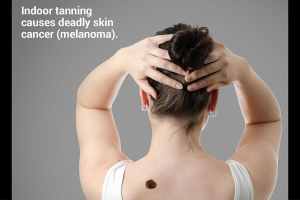Doctoral candidate Jennah Sontag and Professor Seth Noar work to reduce indoor tanning

UNC Hussman School of Journalism and Media Professor Seth Noar and doctoral candidate Jennah Sontag’s report, “Assessing the Potential Effectiveness of Pictorial Messages to Deter Young Women from Indoor Tanning: An Experimental Study,” was published on Sunday, March 7, in the Journal of Health Communication. The report discusses the health risks associated with indoor tanning and suggests that there are more effective ways to communicate the health risks, than text-only messages.
Realizing the harm in tanning bed usage, the FDA reclassified the beds into a stricter device category and included stronger warnings on them in September 2014. However, the warnings did not include images. Sontag says the visual depictions of tanning harms will help users “understand that their appearance is actually at-risk in the long-term.” The researchers found that messages including images showing some of the longer-term effects of tanning beg usage produced higher ratings of effectiveness than text-only messages in a survey of 568 female college students.
Interestingly, the researchers found some images were better at producing negative emotional reactions than others. Messages that showed the longer-term health and appearance-related side effects, such as skin cancer, eye damage and wrinkled skin, were rated as more effective among young women than images showing immediate tanning risks, like burns and infections. After discovering that some found the text-only messages to be more believable than those that included images, the researchers concluded that the warning images must seem realistic in order to be affective.
Although the health risks associated with indoor tanning beds are clear, its use is still popular among young, non-Hispanic white women. According to the 2010 National Health Interview Survey, as many of 32 percent of women aged 18 to 21 years used tanning beds, and 30 percent of white women aged 22 to 25 years reported using them. The long-term risks of indoor tanning before age 35 include increased risk of melanoma by 75 percent, according to a 2006 analysis. Melanoma is the deadliest skin cancer and is caused by exposure to ultraviolet (UV) light. A 2009 study found tanning beds’ fluorescent bulbs generate UV radiation that is three times more intense than the sun. Noar says “reducing tanning bed use will lead to reductions in skin cancer, and this is a ‘winnable battle.’”
The study was supported by UNC Lineberger and the University Cancer Research Fund.